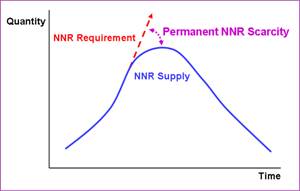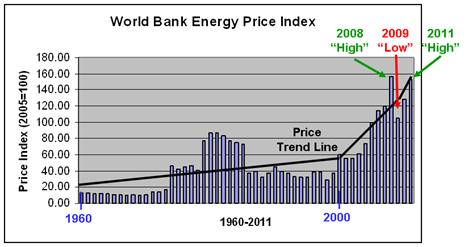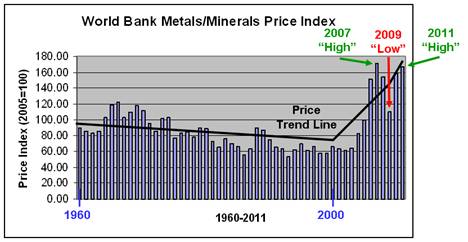
Permanent NNR Scarcity
|
Nonrenewable Natural Resource (NNR) scarcity is becoming increasingly prevalent globally. That is, globally available, economically viable supplies associated with an ever-increasing number of the fossil fuels, metals, and nonmetallic minerals that enable our industrial lifestyle paradigm:
Have become permanently scarce, and will never again be sufficient to completely address our global requirements, or
Are experiencing increasingly severe and protracted episodes of temporary scarcity, and will soon become permanently scarce
as well.
My previous NNR scarcity analyses were based primarily on US Geological Survey (USGS) and US Energy Information Administration (EIA) data. The following NNR scarcity analysis is based on World Bank (WB) NNR pricing data—specifically, pricing data obtained from the WB Energy (fossil fuel) Price Index and the Metals and Minerals Price Index. In summary, my findings from the following analysis derived from World Bank data confirm the findings from my previous analyses derived from USGS and EIA data—global NNR scarcity is becoming increasingly prevalent, and debilitating.

Global Fossil Fuel Scarcity
Annual inflation adjusted World Bank Energy Price Index data for the years 1960 to 2011.
Source:
World Bank
Key observations:
Mid/late 20th century energy prices increased at a 4% compound annual growth rate (CAGR)
between the years 1960 and 1999, driven primarily by OPEC’s continuously increasing
influence on global oil supplies and price levels since the 1970s, and by incipient global oil
scarcity during the later years of the 20th century.
Pre Great Recession energy prices increased at an extraordinary 13.5% CAGR between the
years 2000 and 2008; driven by the historically unprecedented global fossil fuel requirements
engendered by our newly emerging quest for global industrialism, which necessitated the
exploitation of increasingly expensive, lower quality fossil fuel deposits. (Note: “lower quality”
is defined as fewer, smaller, and/or less accessible fossil fuel deposits, typically of declining
grade and/or purity.)
Post Great Recession energy prices increased at a phenomenal 18.9% CAGR between the
years 2009 and 2011, driven by unsuccessful worldwide attempts to reestablish prerecession
global economic growth trajectories.
Early 21st century energy price levels and growth trajectories have been historically
unprecedented, when compared to 20th century price levels and growth trajectories—as
evidenced by significantly “higher highs” in 2008 and 2011, and a significantly “higher low” in
2009—and clearly indicate increasing global fossil fuel scarcity.

Global Metals and Minerals Scarcity
Annual inflation adjusted World Bank Metals and Minerals Price Index data for the years 1960 to 2011.
Source:
World Bank
Key observations:
Mid/late 20th century metals and minerals prices declined at a (negative) -1.5% compound
annual growth rate (CAGR) between the years 1960 and 1999, a time period during which
globally available, economically viable metals and minerals supplies were generally sufficient
or more than sufficient to completely address global requirements.
Pre Great Recession metals and minerals prices increased at an extraordinary 14.3% CAGR
between the years 2000 and 2008; driven by the historically unprecedented global metals
and minerals requirements engendered by our newly emerging quest for global industrialism,
which necessitated the exploitation of increasingly expensive, lower quality metals and
minerals deposits. (Note: “lower quality” is defined as fewer, smaller, and/or less accessible
metals/minerals deposits, typically of declining grade and/or purity.)
Post Great Recession metals and minerals prices increased at a phenomenal 20.1% CAGR
between the years 2009 and 2011, driven by unsuccessful worldwide attempts to reestablish
pre-recession global economic growth trajectories.
Early 21st century metals/minerals price levels and growth trajectories have been historically
unprecedented when compared to 20th century price levels and growth trajectories—as
evidenced by significantly “higher highs” in 2007 and 2011, and a significantly “higher low” in
2009—and clearly indicate increasing global metals and minerals scarcity.
Assertions and Projections
The episodes of global NNR scarcity experienced during the 20th century “commodity
boom/bust cycles” were temporary—i.e., additional economically viable NNR supplies were
readily available to be brought online to completely address global requirements, thereby
resolving temporary NNR supply shortfalls and enabling the restoration of “boom period”
economic growth trajectories.
The episodes of 21st century global NNR scarcity century are permanent in an increasing
number of cases—with permanent scarcity, globally available, economically viable supplies of
an NNR will never again be sufficient to completely address global requirements.
Global economic growth was throttled in mid 2008 and again in early 2011, as unacceptably
high NNR price levels curtailed both global NNR demand/utilization and global economic
output (GDP). The underlying cause associated with both the Great Recession and the
aborted post-recession economic recovery was ever-increasing NNR scarcity.
Global NNR scarcity will intensify going forward, thereby precluding a permanent recovery
from the Great Recession. Each attempt to reestablish pre-recession economic growth
trajectories will increase NNR demand; which will force NNR suppliers to exploit increasingly
expensive, lower quality NNR deposits; which will cause NNR prices to increase; which will
curtail NNR demand and utilization; which will curtail economic output (GDP); which will abort
the attempted economic recovery.
This Time Really IS Different
Why?
With the seemingly continuous emergence of newly industrializing nations in Asia, Africa, and
Latin America, global requirements for the earth’s finite and non-replenishing NNRs have
increased meteorically since the beginning of the 21st century. Whereas approximately 1.5 billion
people occupied industrialized and industrializing nations in the late 20th century, that number
currently exceeds 5 billion, most of whom have yet to even remotely approach their full NNR
utilization potential.
Moreover, our ever-increasing global NNR requirements are manifesting themselves within the
context of increasingly-constrained—i.e., increasingly expensive, lower quality—NNR supplies.
The unfortunate consequence of this “demand/supply mismatch” is that the earth cannot
physically support humanity’s current—much less continuously increasing—NNR requirements.
Global NNR scarcity was inevitable; the persistent utilization of finite and non-replenishing NNRs,
especially at levels required to perpetuate our industrial lifestyle paradigm, is unsustainable by
definition. Our quest for global industrialism during the past several decades merely expedited the
onset of epidemic global NNR scarcity.
So?
As global NNR scarcity becomes increasingly prevalent going forward, the economic output
(GDP) levels associated with an increasing number of industrialized and industrializing nations
will peak permanently and enter terminal decline, as will the societal wellbeing levels—the
population levels and material living standards—associated with these nations.
Diminishing NNR Input
Diminishing Economic Output (GDP)
Diminishing Societal Wellbeing (Population and Material Living Standards)
This scenario is currently unfolding in most industrialized Western nations, including the United
States, and will soon occur in the newly industrializing nations as well.
Our historical reality of “continuously more and more”—which we in the industrialized West have
experienced since the inception of our industrial revolution and have come to take for granted—is
giving way to our new reality of “continuously less and less”. And judging by the ever-increasing
incidence of global economic turmoil, political instability, and social unrest; we will not accept our
new reality gracefully.
Metaphorically, ever-increasing NNR scarcity is exerting a relentless, remorseless squeeze, like a
vise tightening around the collective skulls of humanity. And while the vise handle turns almost
imperceptibly at only 1/1000 of a revolution per day, the handle will make 3 complete revolutions
within the next 10 years, 6 complete revolutions within the next 20 years, 9 complete revolutions
within the next 30 years...
In the absence of an intelligent response to our “predicament”—which I have yet to encounter—
humanity will crack somewhere along the way.
NNR scarcity is the most daunting challenge ever to confront humanity.
If we Homo sapiens are truly an exceptional species, now is the time to prove it.
Note: The key assumption underlying the preceding analysis is that increasing NNR prices—especially dramatically and persistently increasing NNR prices—result from NNR scarcity. If this assumption is invalid, please offer a plausible alternative explanation for the historically unprecedented NNR price increases experienced during the early years of the 21st century.
RELATED PAPERS
Sustainability Defined, Chris Clugston, Wake Up Amerika, 2009.
Continuously Less and Less—The New American Reality, Chris Clugston, Wake Up Amerika, 2009.
Increasing Global Nonrenewable Natural Resource Scarcity—Prelude to Global Societal Collapse, Chris Clugston, Wake Up Amerika, 2010.
Working Paper: Ever-increasing Nonrenewable Natural Resource (NNR) Scarcity, Chris Clugston, Wake Up Amerika, December 2011. Available via email request.
Forthcoming Book: Scarcity—Humanity’s Final Chapter?, Chris Clugston, Wake Up Amerika, January 2012. A PDF copy of this paper is available via email request.
© Copyright 2012 Wake Up Amerika! All rights reserved.
Chris Clugston worked for thirty years in the high technology electronics industry, primarily with information technology sector companies. He held management level positions in marketing, sales, finance, and M&A, prior to becoming a corporate chief executive and later a management consultant. Since 2006, he has conducted extensive independent research into the area of “sustainability”, with a focus on nonrenewable natural resource (NNR) scarcity. He has sought to quantify, from a combined ecological and economic perspective, the extent to which America and humanity are living unsustainably beyond their means, and to articulate the causes, magnitude, implications, and consequences associated with this “predicament”. Mr. Clugston holds an AB/Political Science, Magna Cum Laude and Phi Beta Kappa from Penn State University, and an MBA/Finance with High Distinction from Temple University. He can be contacted at coclugston@gmail.com.